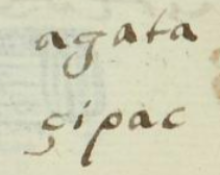Cipac (MH632v)
This black-line drawing of the simplex glyph for the personal name Cipac (“Crocodile,” attested here as a woman’s name) shows a profile view of a crocodile, facing toward the viewer's right, with its mouth open. Its skin has some texturing, and it is painted a dark gray or black. Its mouth appears to be open.
Stephanie Wood
This name is a day sign. Originally, a name like this would have a number attached to it. But calendrical names were evolving at the time of this manuscript (1560), often dropping their numbers. This day sign comes from the tonalpohualli, the 260-day divinatory calendar. Calendrics figure importantly in Nahuas' religious views of the cosmos. The thirteen-day cycle that was started by One-Cipactli was an auspicious time to be born according to a downloadable publication hosted by Mexicolore.
Stephanie Wood
agata
çipac
Ágata Cipac
Stephanie Wood
1560
Jeff Haskett-Wood
cocodrilos, cocodrilo, cipactli, caimanes, días, fechas, calendarios, animales, nombres de mujeres, viudas

cipac(tli), crocodile, caiman, or alligator, https://nahuatl.wired-humanities.org/content/cipactli
Cocodrilo
Stephanie Wood
Matrícula de Huexotzinco, folio 632r, World Digital Library, https://www.loc.gov/resource/gdcwdl.wdl_15282/?sp=347st=image.
This manuscript is hosted by the Library of Congress and the World Digital Library; used here with the Creative Commons, “Attribution-NonCommercial-ShareAlike 3.0 License” (CC-BY-NC-SAq 3.0).









